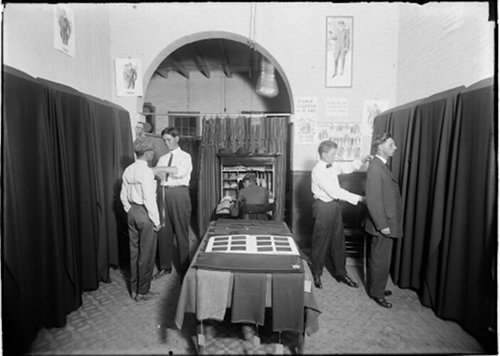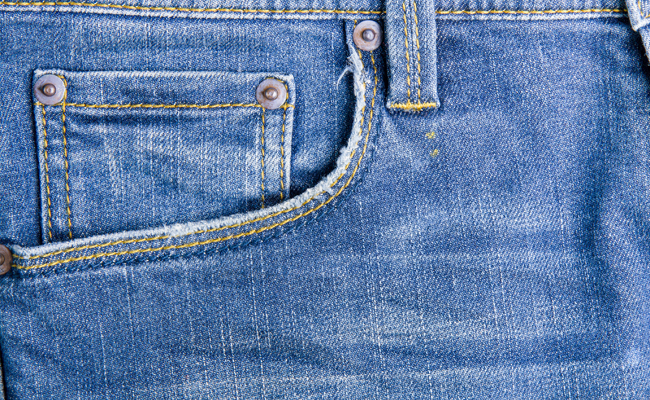
Way back in 2010, I bought a vintage wool mackinaw cruiser on eBay.
Boy, was it a handsome jacket.
I got a great winter season of wear out of it.
When spring arrived, I put my mackinaw in the coat closet and forgot about it.
When we had our first cold snap the subsequent fall, I opened the closet door and took my mackinaw off the hanger, only to notice several holes scattered throughout the coat.
A pack of wool-eating moths had savaged my poor jacket.
If you want to prevent your clothing from facing a similar fate, read on for some clothes-saving tips.
Clothing Moths: Know Your Enemy
If you see moths flying around your house, they’re probably not the kind of moths that eat clothes.
The two species of moths that eat clothing material are case-bearing (or casemaking) clothes moths and common (or webbing) clothes moths. They’re tiny (about 1 cm) and like to stay in the dark, which is why you probably won’t see them eating your clothes.
Both moths prefer snacking on clothes made from materials that originate from animals: wool, leather, feathers, and fur. You know — the kind of materials that make up your nicer, more expensive clothes like cashmere sweaters . . . and mackinaw cruisers.
Clothing moths are snooty; they generally avoid plant-based fabrics like cotton and steer clear of synthetic fabrics. Only the best, protein-rich fibers for these babies.
Clothing moths damage your clothing when they’re still tiny larvae. The larvae munch on your clothes like caterpillars on cabbage leaves. All that delicious animal material prepares them to metamorphosize into mature winged moths. If you do get a chance to see a small, winged clothing moth flying in your closet, it’s probably already eaten its way through your clothing.
Besides clothing moths, another potential clothes-destroying insect to be aware of is the carpet beetle. They’re bigger and easier to see, and you can often kill carpet beetles before they start chewing through your clothes. Like clothing moths, carpet beetles like to eat clothes made from animal products.
How to Protect Clothing from Moths
Clean clothes before you put them away (both daily and for the season). The heat from the hot water cycle on your washer and a tumble in the dryer will kill moths in your clothes. But most clothes that are susceptible to moths (sweaters, suits) are more delicate in nature and shouldn’t be given the washer/dryer treatment. Instead, when you take these garments off for the day, spot clean them to remove any hair or food particles, as these things will attract moths. Give your suit a brushing before you hang it back up; this will remove the aforementioned debris, as well as skin cells and pet dander, which moths also like. A good brushing will help your suit last longer anyway.
When your delicate, moth-vulnerable clothes become more soiled, get them dry-cleaned; dry-cleaning will kill any eggs or larvae embedded in them.
Be sure to also dry-clean your garments before putting them away for the season. This will keep your clothes from smelling musty when you take them out of storage, but more importantly, dry-cleaning will kill any moths lurking in your clothing.
Store clothing when not in use. Your best bet in protecting your clothes from moth damage is to store them in airtight plastic bags and tubs when you’re not using them for the season.
This was my fatal mistake with my mackinaw. I just hung it up in a dark, musty closet — the kind of environment in which clothing moths thrive.
For coats and suits you wear in the colder months, store them away in garment bags once winter is over. Make sure to duct tape off the hole at the top of the bag that the hanger goes through. Clothing moths will take advantage of any crevice to get to your tasty, tasty garments.
Compression bags are great for storing winter sweaters. They keep moths away from your clothes and save space.
Use cedar and lavender if you wish, but not exclusively. One common tactic to repel moths is using cedar (in the form of hanger blocks, balls, and chests) and lavender (in the form of flower buds tied up in a sachet). Cedar has natural oils that kill clothing moth larvae, but don’t work against eggs or adults. Lavender doesn’t kill eggs or larvae, but the scent does seem to repel adult clothing moths.
The effect of cedar and lavender fades with time. You must keep replenishing your drawers with new cedar balls or lavender bags.
Given their lack of full, egg-to-adult efficiency and their expiring nature, experts don’t recommend relying solely on cedar and lavender to prevent moth damage.
By all means, hang a lavender bag or cedar block in your closet (they smell nice, if nothing else), but make sure to keep your wool clothing in appropriate containers for long-term storage.
What About Mothballs?
When you think about protecting your clothes from moths, you probably think of mothballs. Your grandparents may have used mothballs, and when you catch a whiff of them today, the smell instantly transports you back to their house.
Back in the day, synthetic clothes (and carpets) hadn’t made their debut yet, so folks had more woolen items for moths to lodge in and feed on. So moths were a bigger issue for our grandparents than they are for us, and to protect their clothes, they reached for an effective, if odoriferous, solution: mothballs.
While mothballs are still around today, they’re not an ideal strategy for dealing with moths.
Mothballs work by releasing a gas that kills moths in all their developmental stages. You put some in with clothes inside a sealed container, and the balls fumigate that container and the clothes within it.
When you use mothballs, you shouldn’t be too exposed to their fumes because they’re released inside a sealed container, and when you go to remove your clothes from it, you should do so in a well-ventilated area, let the clothes air out for a few days, and then wash them before wearing. But even though you can minimize your exposure and there are newer formulations of the product that are less smelly, mothballs are still a chemical pesticide associated with ill health effects.
So only consider using mothballs if you have a severe clothing moth infestation and nothing else has worked to keep your clothes from getting munched on. They also work against carpet beetles.
What to Do If You Have a Clothing Moth Infestation
Storing and cleaning your clothes regularly will go a long way in preventing moth damage.
If you do find clothing moths have hit your wardrobe, you’ll need to do some clean-up to prevent further damage:
Throw away clothing that’s been significantly damaged. First, you can’t use that clothing anymore because moths have chewed a bunch of holes in it. Second, that garment likely has clothing moth eggs that will hatch into clothing moth larvae that will eat the rest of the clothing in your closet. To prevent that, throw away your damaged clothing.
Launder and dry-clean the clothes you keep. We’re trying to kill any lingering eggs and larvae to prevent further damage.
Thoroughly vacuum closet. Again, we’re trying to eliminate moths in any state that will be the source of more damage.
Use mothballs as a last resort. The above should do the trick in cleaning up a clothing moth infestation, but if it doesn’t, bust out the mothballs. Continue keeping your clothes and closet clean.
The above also works for carpet beetles.
There you go. How to protect your clothing from moths.
Vintage mackinaw cruiser that I bought on eBay . . . your death was not in vain! The sacrifice of your handsome garment life will help save another’s. Rest in peace, my friend.







